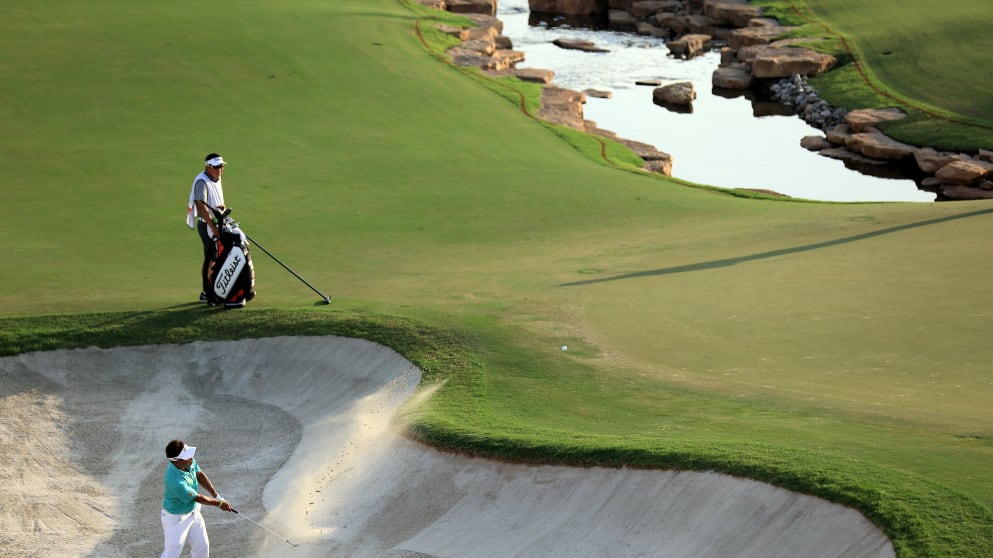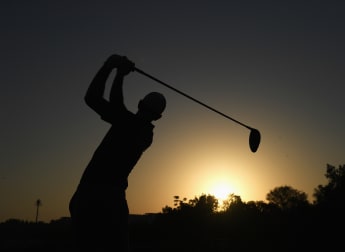Ahead of the season-ending DP World Tour Championship in Dubai, europeantour.com explores ever-present host venue, Jumeirah Golf Estates, as 2017 rookie Alexander Björk gives his first impressions of the well-regarded Earth Course.

Opened in 2009 ahead of the inaugural edition of the tournament, the Earth Course measures a significant 7,675 yards from the championship tees and plays to a par of 72.
Designed by two-time Major winner Greg Norman, and inspired by the great parkland courses of Europe and North America, Jumeirah Golf Estates is set against a backdrop of barren desert but with its rolling fairways, pristine white bunkering, vast and undulating greens, and abundance of trees, shrubs and wildlife it presents an oasis of verdant green for a world-class field each and every year.
This week hosting the European Tour season finale for a ninth consecutive year, Justin Rose holds the Earth Course scoring record thanks to a blistering 62 in 2012, while Rory McIlroy and Henrik Stenson have each won two titles here so the cream has often risen to the top at Jumeirah Golf Estates.
Playing the venue for the first time this week, European Tour rookie and 2016 Challenge Tour graduate Björk has made a strong start to his career on the top tier of European golf, claiming seven finishes inside the top 15 this year including a lucrative third place at July’s HNA Open de France.

Coming into the week ranked 43rd in the Race to Dubai, 2017 has been something of a whirlwind for the Swede.
“I felt quite comfortable even before France, because I had a tie for 15th at Leopard Creek, a tie for 13th in Abu Dhabi and another share of 15th at the Tshwane Open. I felt like I was continuing my game from the Challenge Tour, so it was nice to feel from the beginning that I actually belonged.”

Overview
“It’s a very nice course to look at, especially from the tee with all those big bunkers. It’s always a challenge with those big slopey greens and you need to hit the right parts, because it is so slopey and grainy. The challenge will be the iron play from the fairway to the greens, trying to give yourself good birdie chances.
Timing in the draw
“I’m not worried about being early in the draw, but of course throughout a round you can have quite a cool air and the ball goes 10 or 15 metres shorter than you’d get later in the round. But I think you can get that every week, so you get used to it.
“At 15 degrees it might not go far and then you find it will fly a little further. Of course, it’s nicer when it goes longer, because you can fly some of the bunkers and you have shorter irons in to the green.”
Greens

Key holes
18th hole – Par five – 620 yards
“There are also two reachable par fives on the front nine, the second and the seventh. If you can make easy birdies there you’ll give yourself a good start.”

How it’s played in previous years
The average score at the Earth Course has been 70.6 strokes (1.4 shots under par) since 2009 with a spread of 25 under par as the lowest winning score (Henrik Stenson in 2013) to as high as 14 under par (Robert Karlsson in 2010).
There have been two big wins in tournament history here, with both Stenson in 2013 and Lee Westwood in 2009 triumphing by six shots.
Greens in Regulation are relatively easy compared to other European Tour courses with more of an emphasis on birdie-making, playing the par fives well and avoiding three putts on the large green complexes at Jumeirah Golf Estates.
Of any player in the field with more than ten rounds at the DP World Tour Championship, last year’s runner-up Tyrrell Hatton has the lowest scoring average of 68.9 from 12 rounds here.
Hole superlatives
Most likely to be birdied – Seventh hole (41 per cent birdie or better)
Most likely non-par five to be birdied– 15th hole (34 per cent birdie or better)
Most likely to be bogeyed – 12th hole (23 per cent bogey or worse)
Easiest GiR – Seventh hole (89 per cent)
Toughest GiR – Ninth hole (57 per cent)
Easiest fairway to hit– Fifth hole (86 per cent)
Toughest fairway to hit– 18th hole (59 per cent)







